Infrared heater for efficient heat processes in industry
- Details
- Hits: 10827
Infrared heater from Excelita's Noblelight play a crucial role in modern industry. With their ability to deliver heat precisely and efficiently, they optimize numerous industrial processes, from material processing until final production. Find out how Infrared Heaters Make industrial applications more efficient and of better quality and why they are considered a key technology for energy-efficient heating processes.
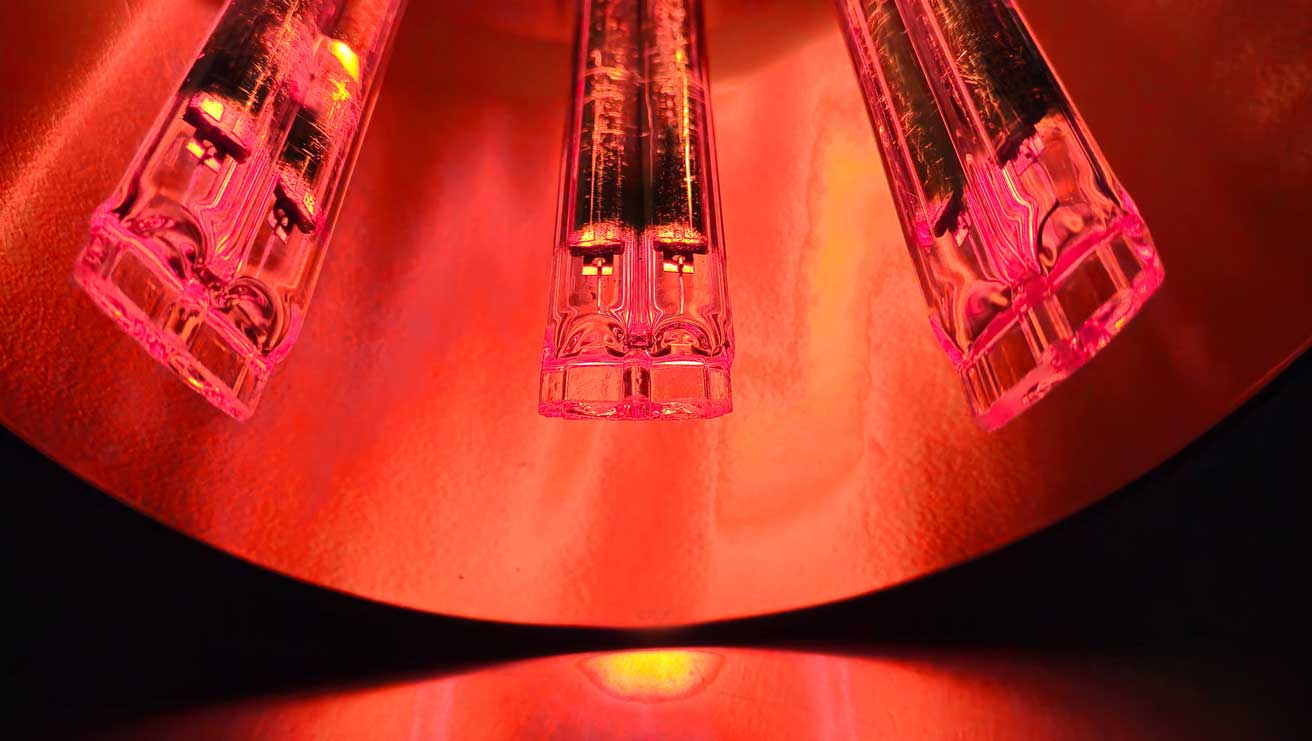
Contents
- Infrared heater industry – sustainable, efficient, intelligent
- Intelligent infrared heat saves up to 80% energy
- Thermal deburring contour-adapted for plastic parts
- Infrared emitters for high-quality car interior designs
- Infrared heaters increase energy efficiency in tool production
- In mold decoration production with infrared and UV emitters
- Infrared heater for the smallest edges and burrs on plastic parts
- Infrared emitters save energy when powder coating
- FAQ
Infrared heater industry – sustainable, efficient, intelligent
Discover the advanced applications of infrared heaters from Excelita's Noblelight (formerly Heraeus Noblelight) in industry, providing constant, targeted heat for optimized manufacturing processes. The current trend towards energy-efficient and sustainable solutions has also brought infrared technology into focus. Explore how the latest developments in infrared heaters can make your production processes more efficient and thus sustainably reduce costs:
Intelligent infrared heat saves up to 80% energy
26.02.2024/XNUMX/XNUMX | Not all workpieces have flat, even contours without undercuts. Coating them, finishing them or protecting them with anti-corrosion paint can be a challenge. It's good that the electric infrared heaters from Excelitas Noblelight are available: they are ideal for you Workpiece contour adjustable and direct the heat exactly to the right place. If you combine them with an electric hot air oven, shadowy areas can be avoided. Tests show that up to 80% energy can be saved through adapted infrared systems, which not least meets the Ecodesign Regulation.
Excelitas Noblelight will be presenting at the trade fair in April PaintExpo its advanced infrared and UV technology with UV LED and microwave systems for future-proof coating processes. Drying paints, varnishes and coatings usually requires a lot of energy. With outdated drying systems, this can quickly lead to a lot of time, which causes a bottleneck in production and is also cost-intensive.
 Infrared thermometer with smartphone & tablet app
Infrared thermometer with smartphone & tablet app
Infrared radiation can help here when used in industrial processes. Here, heat is transferred in the form of electromagnetic radiation without an intermediate medium. It is particularly important to carefully coordinate the infrared heaters with the Workpiece properties in terms of shape, wavelength and power. Infrared radiation, which is precisely tailored to the absorption properties of the paint, is quickly converted into heat. As the material and environment remain cooler, water or solvents evaporate.
Extensive tests have shown that carbon infrared heaters dry water-soluble paints much more efficiently than short-wave infrared heaters. A carbon spotlight is required up to 30% less energy for the drying process than the conventional halogen lamp.
Infrared booster and electric hot air oven
However, infrared technology cannot only replace conventional solutions. It often complements existing ovens in the form of additional heating. A Infrared booster in front of a hot air oven often ensures more efficient drying. Complex components in particular benefit from the symbiosis of both technologies. Excelitas Noblelight has proven it in a test line consisting of an infrared booster and an electric hot air oven. In our own application center, particularly practical tests were carried out using the Vötschoven from Weiss Technik and the infrared technology from Noblelight.
 Reading tip: Scan walls with Walabot wall scanner
Reading tip: Scan walls with Walabot wall scanner
The infrared radiation quickly brings products to the desired temperature, while the electric Convection Oven ensures that the parts are heated homogeneously – even with special contours. Practical testing helps with the optimal configuration of the future system. It also gives customers a feeling of security when making a planned investment. The infrared boosters and the electric hot air ovens can later be combined in a modular manner. This modularity makes the configuration of the system flexible.
The infrared and hot air combination has been tested with various products since the oven line was set up - with pleasing results. Metal components were coated with black powder paint. The thermocouples monitored the heating in the hot air oven with and without a booster. In most cases there was a significant reduction Time to heat up by up to 80% with the infrared booster.
Thermal deburring contour-adapted for plastic parts
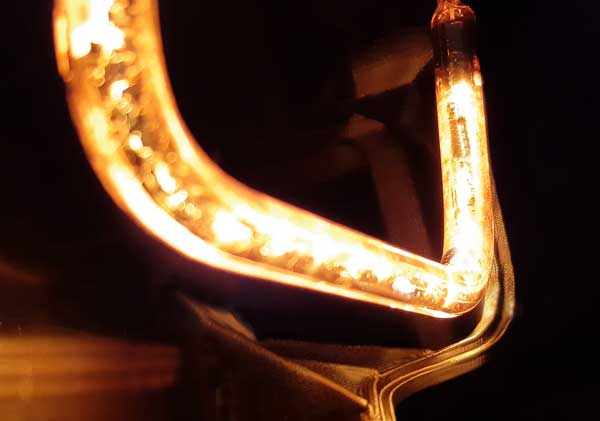 Oct 16.10.2023, XNUMX | If burrs cannot be avoided in plastic molded parts, they must at least be removed easily and reproducibly, because they interfere with further processing. Heraeus Noblelight will be showing how this works and how modern infrared systems can be precisely adapted to the contours at the Fakuma 2023 in Friedrichshafen.
Oct 16.10.2023, XNUMX | If burrs cannot be avoided in plastic molded parts, they must at least be removed easily and reproducibly, because they interfere with further processing. Heraeus Noblelight will be showing how this works and how modern infrared systems can be precisely adapted to the contours at the Fakuma 2023 in Friedrichshafen.
Infrared modules from Heraeus can be tailored precisely to existing processes. Infrared heat works contact-free and so will Burrs melted awaywithout damaging the product. This means that the reject rate in the production of molded parts can be significantly reduced.
Covers, intake pipes, lids, handles or housing parts made of plastic are often used Injection molding process manufactured. This sometimes creates sharp-edged burrs, for example on the tool parting plane, which cannot always be prevented. For complicated shaped parts, burr removal before further processing or coating can be particularly challenging.
Infrared emitter made of quartz glass
Heraeus has a solution for this: turn off the IR emitter Quartz glass can be shaped to follow the course of edges or ridges. This means they only melt off the burr without damaging the actual workpiece.
This makes them superior to many conventional methods because they quickly produce uniform results, which is not the case with manual removal, for example with special knives or by using gas flames. Infrared modules are compact and easy to integrate into production. This is what infrared heat does Inline deburring possible and plastic parts can be further processed immediately.
Infrared emitters can also be precisely tailored to the production step, from the large surface to the narrow edge. They are flexible and also on complex shaped workpieces customizable. Energy is also saved because infrared heaters can be switched on or off in seconds.
Infrared heat emitters as Contour radiator can also be used optimally robots or handling systems can be networked.
Infrared emitters for high-quality car interior designs

Infrared emitters ensure the quality of the interior of automobiles, for example. When it comes to a new car, you rely on modern design with materials such as polycarbonate and ABS, and often mixtures of both. Dashboards, infotainment panels or other interior panels are manufactured using injection molding and then further refined. Infrared heaters for contours from Heraeus Noblelight ensure quality here.
The Surfaces Such components should be perfect, smooth and without annoying burrs. Infrared contour radiant heaters precisely round the burr without damaging the workpiece. Manual deburring with gas flames or special tools does not produce consistently reproducible results. The intermediate step of manual deburring costs time and in-line production is not possible.
Infrared emitter off Quartz glass can be shaped to follow the course of edges or burrs and thus precisely melt only the burr without damaging the actual workpiece. The infrared heaters deburr within 4 to 12 seconds, depending on the material and the thickness of the burr. This means that deburring takes place much faster than with a corona flame, which gradually traces a contour with a burr. With an infrared contour heater the entire ridge can be in one step be melted at the same time.
Infrared heaters increase energy efficiency in tool production
 08.08.2022/XNUMX/XNUMX | The single ones manufacturing processes of Plastics are expensive and require a lot of energy. In the heat processes of lining, laminating, embossing and weldingWhen performing riveting, riveting or deburring, it is therefore advantageous if the energy is only used where it is needed. Electric IR emitters are ideal for this because they can be precisely adjusted, making complex heating processes reliable and automatable. In addition, infrared systems react very quickly, which is why energy is not wasted on preheating, standby or loss to the environment. Heraeus Noblelight presents at the trade fair K 2022 in Düsseldorf Infrared radiators and systems that transmit heat particularly energy-efficiently.
08.08.2022/XNUMX/XNUMX | The single ones manufacturing processes of Plastics are expensive and require a lot of energy. In the heat processes of lining, laminating, embossing and weldingWhen performing riveting, riveting or deburring, it is therefore advantageous if the energy is only used where it is needed. Electric IR emitters are ideal for this because they can be precisely adjusted, making complex heating processes reliable and automatable. In addition, infrared systems react very quickly, which is why energy is not wasted on preheating, standby or loss to the environment. Heraeus Noblelight presents at the trade fair K 2022 in Düsseldorf Infrared radiators and systems that transmit heat particularly energy-efficiently.
Heat is not just heat. Infrared emitters make the difference. This shows an example of the British company Hepworth drainage: The use of infrared emitters here improved a process in plastics processing, in which parts of an inspectiontoolss for ducts made of polypropylene. Various tubes are to be connected to a base unit. Hot glue was used for this in the past. Hepworth was looking for more efficient solutions to save money and protect the environment.
The new electric heaters are needed now only 22 sto use in a complex, automated process robots to bring the different pieces together and weld them together. The cycle times for plastic inspection chambers have been significantly shortened while the quality of the product has been significantly increased. The new heating process is also environmentally friendly. In contrast to the previously used hot glue method, there are now significantly fewer vapors. The process-improving infrared emitters were shaped three-dimensionally after the product. In this way, the heat is generated exactly where it is needed. And because the infrared heaters are only switched on when heat is needed, this saves additional energy.
In mold decoration production with infrared and UV emitters

17.08.2021/XNUMX/XNUMX | Whether switches with a metal look, decorative strips in the Cars or high-gloss faucets: they will all be made from Plastic Injection Molding manufactured and then coated on the outside. This is often done using the in-mold decoration (IMD) process, also known as inmold decoration or foil back injection molding. Heraeus Noblelight works with the IMD technology Leonard Short, Specialist in thin-film technology.
In the In-mold decoration method, a carrier product with decorative paint is placed inside the injection mold. As the mold is filled with plastic, varnish or paint adheres to the surface of the plastic casting. When the mold is opened, the paint detaches from the carrier and sticks to the plastic part. The coated part can be removed.
The entire in-mold decoration process benefits from the Infrared (IR) and Ultraviolet (UV) technology from Heraeus Noblelight. Because the coated transfer product can be processed much better if it is preheated by infrared radiation and thus deformable. After injection molding, the paint is hardened by UV radiation and is therefore particularly scratch-resistant.
Leonard Short develops and produces innovative solutions for surface refinement and functional coatings that are applied to substrates. These are used for a wide variety of products, such as in vehicles, the Electronics, household appliances or furniture. If IMD technology is used, injection molding and hot stamping are combined in one step. The IR heat emitters support the process. The IMD components are manufactured in a Baier facility with CO2 cleaned of residues and then cured with UV radiation.
Spot light infrared emitter for car interior trim
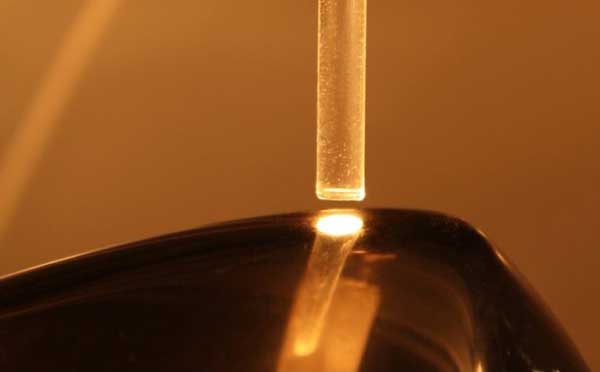 28.08.2018/XNUMX/XNUMX | Heraeus Noblelight shows with the Point light infrared emitter the latest development in the area of contour-adapted infrared heaters. The radiant heater transfers heat precisely and specifically to the smallest of areas, without complicated reflector systems or complex safety precautions. This makes the infrared heater ideal for automated deburring, riveting or welding of plastic parts.
28.08.2018/XNUMX/XNUMX | Heraeus Noblelight shows with the Point light infrared emitter the latest development in the area of contour-adapted infrared heaters. The radiant heater transfers heat precisely and specifically to the smallest of areas, without complicated reflector systems or complex safety precautions. This makes the infrared heater ideal for automated deburring, riveting or welding of plastic parts.
Car interior panels have to fit, the containers for brake fluid or washer fluid have to be tight and that Steering wheel must not have any sharp burrs. These plastic parts are riveted, welded or deburred. Contour-adapted infrared emitters reliably do this even in difficult corners and edges.
In this way, particularly difficult processes can be automated. In contrast to manual methods, this noticeably reduces rejects. The point light infrared heater delivers up to 500 kilowatts/m2. The infrared heater can direct this power to areas as small as 5 mm in diameter. The industrial infrared heater IR does not require any accessories such as lenses or complicated reflector systems like conventional heaters and no complex safety precautions such as laser sources. It also responds very quickly to control commands and can therefore be easily combined with robot-assisted processes.
The real one Heat source consists of a short-wave IR emitter with QRC coating, which only allows the infrared radiation to exit into a quartz tube that acts as a light guide. Depending on the specifications of the process, this light guide is directed at exactly the point that needs heat. Precise heating prevents heat damage in the surrounding area, sensitive electronics or coated surfaces are protected.
Infrared emitters save energy when powder coating
03.03.2015/XNUMX/XNUMX | Paint on bodies, aluminum rims, fuel tanks or bumpers, stone chip protection on rocker panels or corrosion protection on brake pads: there are countless surfaces in the manufacture of a car that painted or coated will. Heraeus Noblelight presents application-optimized gas catalytic and electric infrared emitters that accelerate powder coating.
For the car owner, it goes without saying that all coated parts in the interior, on the body or on the rims are of perfect quality. For the manufacturer, however, this can be a real challenge in individual cases. Industrial coatings are applied and dried or hardened, often assisted by the supply of heat. In most cases, hot air or infrared heaters are used. The small space requirement and the targeted use of energy make infrared an attractive source of heat.
Powder paint is often used to coat metal parts. Powder coating is applied as a powder, melted by heat and finally hardened. Infrared emitters transmit heat without a contact medium, with the help of electromagnetic waves that only generate heat in the material. Since infrared heat is transferred quickly and with high output, a much shorter furnace is possible in most cases or the production speed can be increased.
Infrared heater industry in the production of aluminum rims
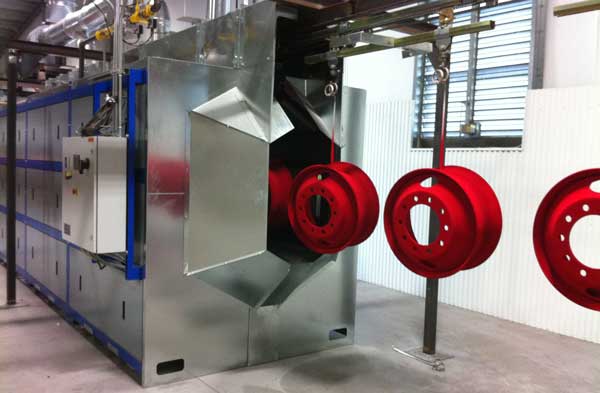 A global supplier of aluminum rims for the automotive industry uses infrared emitters for Coating its rims. As part of a restructuring of production, the previously used hot air oven was replaced by a CIR carbon infrared heater from Heraeus Noblelight.
A global supplier of aluminum rims for the automotive industry uses infrared emitters for Coating its rims. As part of a restructuring of production, the previously used hot air oven was replaced by a CIR carbon infrared heater from Heraeus Noblelight.
Infrared radiation is very well absorbed by powder Powder mass heats up quickly. Powder gels considerably faster than in a convection oven. Without air movement, dust inclusions are avoided, powder is not swirled or carried away. Rapid melting improves the paint quality and increases the throughput speed.
The new Infrared oven for the aluminum rims can vary between different burn-in times. This enables a quick product changeover. In addition, short-wave and carbon infrared emitters have very short reaction times in the range of seconds. This allows you to control the heat.
The additional link with a Temperature control helps to prevent the material from overheating. Gas catalytic emitters convert natural or propane gas into water and carbon dioxide using a special platinum catalyst, releasing medium to long-wave infrared radiation. This flameless reaction differs from conventional gas infrared systems, in which the gas is burned.
Powder paint on metal parts can be done very well with the help of gas catalytic infrared ovens hardened. The design of the ovens is adapted to the product so that the radiation can be optimally used to gel and harden the powder coating. Often the gas catalytic ovens are also used directly in front of a hot air oven to gelatinize the powder, which then hardens due to the convection heat.
FAQ
Are infrared heaters energy guzzlers?
Whether infrared heaters can in principle be viewed as energy guzzlers depends on various factors, such as: b. Efficiency, performance and Useful life. Infrared heaters can be energy efficient if they are used specifically and as needed. They generate heat through radiation that is transferred directly to people and objects rather than heating the surrounding air. This is more efficient than conventional convection heaters. However, you should consider the specific area of application, performance and operating time in order to fully evaluate the energy efficiency and electricity costs.
In industry, IR emitters are often used for their Energy Efficiency valued because they transfer heat directly to an object or surface without heating the air in between. This can occur in industrial processes such as: B. when drying paint or heating materials, lead to a more targeted and therefore more efficient use of energy. Heraeus illustrated this beautifully in this video:
Where are infrared heaters used?
Infrared heaters can be used in a variety of areas for targeted heat transfer, including:
- Manufacturing: For drying, heating, sintering and melting materials and products as well as for hall heating
- Automotive industry: For paint drying processes
- Research and Development: In different experimental setups
- Gastronomy: As heat sources to keep food warm
- Health services: In infrared saunas and cabins or for targeted heat therapy
- Residential: As a heater for indoor spaces and on the outdoor terrace
- Agriculture: For heating stables
What is the difference between infrared heater and infrared heater?
The Main difference The difference between infrared heating and infrared radiators lies in their application and construction: While infrared heating is usually designed for heating rooms and provides an even distribution of heat over a larger area, i.eThe infrared heater often focuses on selective heating and usually produces more intense radiation in order to quickly provide heat in a specific area. The IR emitter is often mobile and flexible in use. The IR heater is typically found in a permanent installation, e.g. B. in ceiling installation.
You might also be interested in...
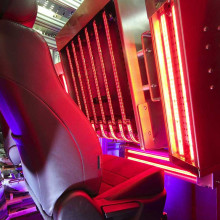
IR and UV emitters for high-quality car interiors
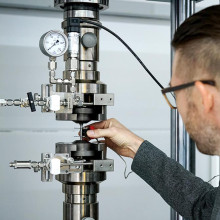
Material testing | non-destructive and destructive

Infrared camera optimizes Laser Powder Bed Fusion 3D printing
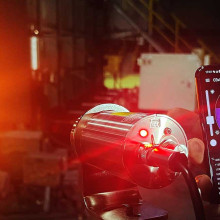
Compact infrared thermometer with smartphone & tablet app

Thermal Imaging Camera | Innovations for industrial applications
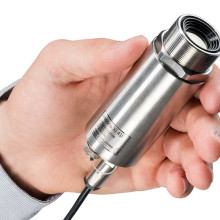
Plug-and-play thermal imaging camera for outdoor, glass and more

Angela Struck is editor-in-chief of the development scout and freelance journalist as well as managing director of Presse Service Büro GbR in Ried.
